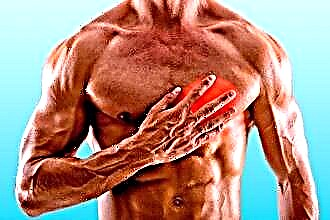 The Buteyko method allows to normalize the work of the respiratory organs, in particular the nasopharynx. What he really is? The Buteyko Method is a set of exercises that was developed in the 60s of the last century by KP Buteyko. The Soviet scientist compiled a special program for patients suffering from the so-called "deep breathing disease". In his opinion, hyperventilation of the lungs, caused by constant breathing through the mouth, negatively affects the patient's quality of life. An excess of oxygen in the body leads to disruption of metabolic processes, which negatively affects the general immunity and, as a result, leads to frequent inflammation of the respiratory tract.
The Buteyko method allows to normalize the work of the respiratory organs, in particular the nasopharynx. What he really is? The Buteyko Method is a set of exercises that was developed in the 60s of the last century by KP Buteyko. The Soviet scientist compiled a special program for patients suffering from the so-called "deep breathing disease". In his opinion, hyperventilation of the lungs, caused by constant breathing through the mouth, negatively affects the patient's quality of life. An excess of oxygen in the body leads to disruption of metabolic processes, which negatively affects the general immunity and, as a result, leads to frequent inflammation of the respiratory tract.
Appointment of breathing exercises
How is breathing exercises useful for adenoids? With the growth of adenoid vegetations, patients develop a persistent habit of breathing only through the mouth. Improper breathing increases the risk of inflammation of the airways, especially the throat, pharynx, and tonsils. Why it happens?
In the nose is the pharyngeal tonsil, which is an immune organ. It filters the air during breathing and thereby prevents the penetration of foreign agents (allergens, viruses, bacteria) into the mucous membranes. In the lymphoid tissues of the organ, immune cells are synthesized, which destroy most of the pathogens that penetrate the ENT organs during respiration.
If the patient constantly breathes only through the mouth, this creates an excessive infectious load on the glands, which, like the pharyngeal tonsil, perform a protective function. With a decrease in immunity, the tonsils (tonsils) cannot cope with the influx of pathogens, which leads to the development of infectious diseases.
Breathing exercises do not affect the size of adenoid vegetations, but only contribute to the restoration of normal nasal breathing.
Regular performance of breathing exercises contributes to the resumption of "unaccountable" automatic breathing through the nose. Thus, it is possible to reduce the infectious load on the tonsils and, accordingly, prevent the development of ENT diseases.
Therapeutic effect
The exercise complexes, which were developed by K. Buteyko and A. N. Strelnikova, have a pronounced therapeutic effect on the body of patients with adenoids. Special techniques not only normalize nasal breathing, but also increase the body's reactivity, i.e. increase its resistance to pathogens. The provided therapeutic effects include:
- normalization of metabolic processes;
- increased tone of the nasopharyngeal mucosa;
- elimination of psychophysical disorders;
- elimination of chronic rhinitis;
- strengthening of general and local immunities.
Exercise is recommended for all patients who have undergone adenotomy. If a child or adult habitually continues to breathe only through the mouth, this will increase the risk of developing inflammation in the nasopharynx. Why?
Irregular nasal breathing leads to disruption of mucociliary clearance and, as a result, stagnation of mucus in the nasal cavity. The viscous secretion contains sugars, which are a breeding ground for the reproduction of yeast-like fungi and microbes. An increase in the number of pathogens leads to the formation of foci of inflammation in the nasal mucosa and paranasal concha.
Improper breathing is the main reason for the accumulation of mucus in the nose and a decrease in local immunity, which can provoke the development of sphenoiditis, sinusitis, ethmoiditis, etc.
Strelnikova's gymnastics
A. Strelnikova is the author of the well-known technique for restoring voice and normal breathing in singers and actors. Despite the fact that official medicine does not recognize gymnastics as an effective method of treating adenoids, it is often recommended for patients suffering from nasal breathing disorders.
Like the Buteyko method, Strelnikova's gymnastics for adenoids is used only for the purpose of eliminating hyperventilation of the lungs.
No exercise helps to reduce the size of the overgrown lymphoid tissues, and even more so to contribute to their resorption. What results can you expect from performing a set of exercises?
- restoration of the drainage function of the trachea and bronchi;
- reducing the number of relapses of ENT diseases;
- improvement of microcirculation of blood in the nasopharynx;
- increasing the tone of the smooth muscles of the respiratory system;
- elimination of congestion in the paranasal sinuses;
- minor correction of chest deformities.
To restore nasal breathing, exercises must be performed daily for at least 3-4 months in a row.
General recommendations
For children, gymnastics is nothing more than a punishment. Therefore, many parents simply cannot force a child to perform a small set of exercises for at least 5-7 minutes. In order to still teach the little patient to breathe correctly, classes should be carried out in a playful way. Therefore, it is advisable to prepare for each therapy session in advance.
It should be understood that the effectiveness of treatment depends not only on the choice of technique, but also on the correctness of the exercise technique. That is why breathing exercises should take place taking into account some rules:
- if the child is no more than 2-3 years old, pick up simple exercises that he will probably be able to perform;
- the duration of gymnastics should not exceed 10-15 minutes (children quickly lose interest in classes, so try to make sure that the exercise does not associate him with torment);
- one-time classes will not give the necessary therapeutic results, so do gymnastics at least 2-3 times a day.
Formal and, accordingly, improper performance of medical complexes is one of the main reasons for the ineffectiveness of breathing exercises.
It is difficult for young children to explain exactly how to do the exercises. However, it is possible to normalize nasal breathing only if all the recommendations prescribed by the authors of the therapeutic techniques are followed. It is impossible to explain exactly what the "lion breath" exercise is to a two-year-old child, but it is quite possible to ask him to breathe intensively through his nose.
Warm-up exercises
Before proceeding to the implementation of the main set of exercises, it is advisable to carry out a short warm-up with the child. According to Strelnikova's recommendations, gymnastics is best performed while standing, since in a sitting position the lungs are only partially straightened. What exercises can be used as warm-up exercises?
 "Palms": bend your elbows so that your palms are facing the "viewer"; making a rhythmic breath through your nose, clench your palms into fists;
"Palms": bend your elbows so that your palms are facing the "viewer"; making a rhythmic breath through your nose, clench your palms into fists;- "Pump": bending your knees slightly, place your arms along your body; leaning forward, take a sharp breath with your nose; having raised a little, take a rhythmic breath again and straighten up;
- "Epaulettes": clench your palms into fists and press them a little to the body at about waist level; during an intense and sharp breath, "push" your arms down (the muscles of the shoulders and arms should be tense); returning to the original position, relax the muscles while exhaling slowly.
Important! In any exercise, inhalation should be performed simultaneously with the movement of the body, and exhalation should be performed while relaxing the muscles and returning to the starting position.
The main set of exercises
Can adenoid vegetation decrease when doing breathing exercises? Despite the fact that the number of structural elements in the adenoids does not decrease, regular exercise still contributes to a slight decrease in the size of the pharyngeal tonsil. This is due to a decrease in tissue swelling that occurs during inflammation and stagnation of mucus in the nasopharynx.
It is not recommended to perform breathing exercises for patients suffering from osteochondrosis and vertebral hernia, as sudden movements can aggravate health and provoke displacement of the intervertebral discs.
Exercises from Strelnikova's main complex are somewhat more complicated in terms of technique than warm-up exercises. However, the correct exercise allows you to quickly restore nasal breathing, and in some cases even eliminate the symptoms of a lingering rhinitis. Some of the most effective breathing exercises include:
- "Big pendulum": bend forward and, pulling your hands to the floor, inhale; bending in the lower back (exhale), hug yourself by the shoulders (inhale);
- "Ears": tilting your head to the left to your ear, take a quick breath, then return to the starting position and tilt your head to the other side to the right ear and also while inhaling;
- "Cat": putting your legs a little wider than your shoulders, do a squat with a quick breath and a simultaneous turn of the body to the left; returning to the starting position, do the same, but when turning to the right.
It is undesirable to perform gymnastics in case of acute inflammation of the ENT organs. If the patient suffers from a chronic rhinitis, before classes, you need to clear the nose of mucus and drip vasoconstrictor drops.

 "Palms": bend your elbows so that your palms are facing the "viewer"; making a rhythmic breath through your nose, clench your palms into fists;
"Palms": bend your elbows so that your palms are facing the "viewer"; making a rhythmic breath through your nose, clench your palms into fists;

